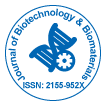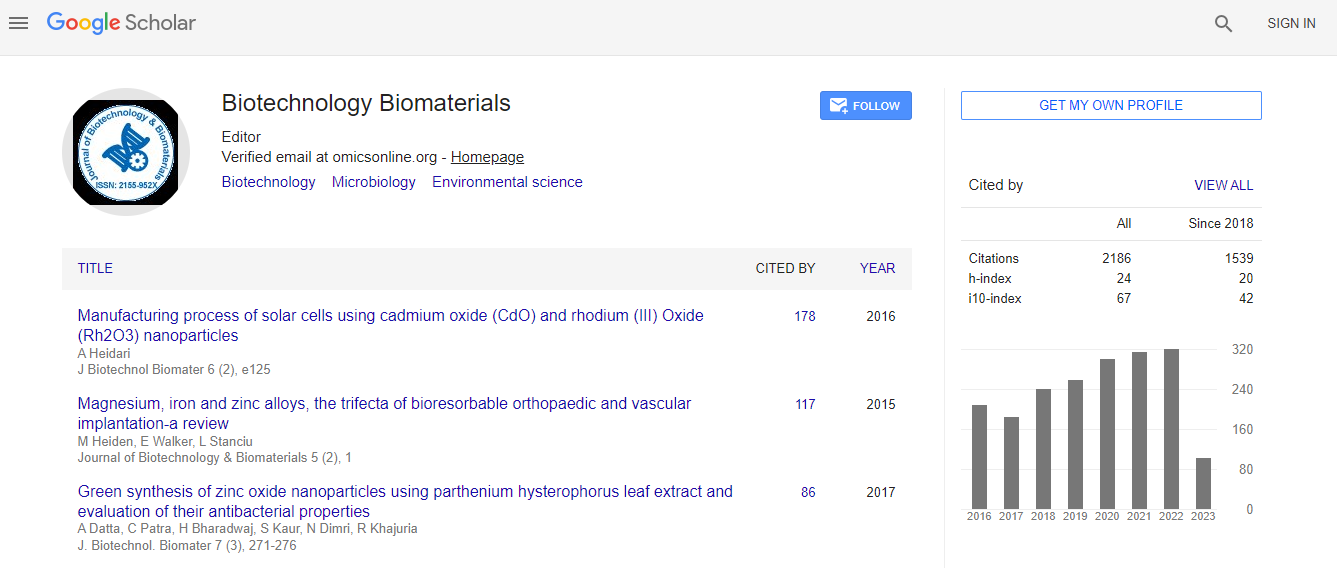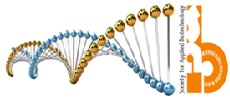Our Group organises 3000+ Global Conferenceseries Events every year across USA, Europe & Asia with support from 1000 more scientific Societies and Publishes 700+ Open Access Journals which contains over 50000 eminent personalities, reputed scientists as editorial board members.
Open Access Journals gaining more Readers and Citations
700 Journals and 15,000,000 Readers Each Journal is getting 25,000+ Readers
Google Scholar citation report
Citations : 3330
Journal of Biotechnology & Biomaterials received 3330 citations as per Google Scholar report
Indexed In
- Index Copernicus
- Google Scholar
- Sherpa Romeo
- Open J Gate
- Genamics JournalSeek
- Academic Keys
- ResearchBible
- China National Knowledge Infrastructure (CNKI)
- Access to Global Online Research in Agriculture (AGORA)
- Electronic Journals Library
- RefSeek
- Hamdard University
- EBSCO A-Z
- OCLC- WorldCat
- SWB online catalog
- Virtual Library of Biology (vifabio)
- Publons
- Geneva Foundation for Medical Education and Research
- Euro Pub
- ICMJE
Useful Links
Recommended Journals
Related Subjects
Share This Page
The identification of natural PPAR ligands using gene reporter assays
3rd World Congress on Biotechnology
AW Thomas, K Morris, N Davies and R Webb
Cardiff Metropolitan University, UK
ScientificTracks Abstracts: J Biotechnol Biomater
Abstract
Introduction: Recent evidence suggests that the risk of developing metabolic diseases such as diabetes can be substantially reduced by activation of specific gene transcription factors called the PPARs (Peroxisome Proliferator-Activated Receptors). The DREAM pharmacological intervention trial (8mg/ml daily dose of Rosiglitazone, a PPAR├?┬│ agonist), showed that the risk of developing diabetes in at risk individuals could be reduced by 50% compared to placebo alone. Also evidence exist that lifestyle changes such participation in low intensity exercise programme can significantly activate PPAR├?┬│ signalling and thus stimulate insulin sensitivity and reverse cholesterol transport. Therefore we aimed to determine whether (1) serum form exercised individuals and/or (2) dietary supplements might contain novel natural PPAR ligands and thus enhance PPAR├?┬▒, ├?┬▓/├?┬┤ and/or ├?┬│ transcriptional activity.Method: Gene reporter assay were used to determine PPAR ├?┬▒, ├?┬▓ and ├?┬│ gene transcription activities. HEK293 cells were transiently transfected with either a PPAR ├?┬▒, ├?┬▓ or ├?┬│ expression vector, a PPRE-Luciferase reporter vector and an internal Renilla control vector using lipofectamine (Invitrogen). Transcriptional PPAR activity was determined by measuring luminescence after 24h incubation with various stimuli using a Dual-Luciferase Reporter Assay System (Promega). The following synthetic PPAR ligands, GW7647, GW0742 and Rosiglitazone were used as positive controls for PPAR ├?┬▒, ├?┬▓/├?┬┤ or ├?┬│, respectively. Also the natural PPAR ├?┬│ ligands, PGJ2 and HODEs were used for comparative purposes.
Results: (1) Exercise study. Addition of plasma samples from participants undertaking an 8 week exercise programme were incubated with HEK cells containing a PPRE-Luciferase reporter vector. PPAR├?┬│ activity increased following the initial standardised sub-maximal exercise bout (├ó┬?┬?Week 0 post/pre:1.23├?┬▒0.10; P<0.05), suggesting that PPAR├?┬│ ligands were generated during exercise. (2) Dietary products study. A variety of dietary products (extracts of tea, honey and Neem seeds (Azadirachta Indica)) were incubated at different concentrations with transfected HEK cells for 24 hours. White tea showed the highest PPAR├?┬│ activity (2.6 fold increase cf control). Organic extracts of manuka honey and neem seeds also showed significant PPAR activities.
Conclusion: This preliminary study presents evidence that exercise generates novel PPAR ├?┬│ ligands and it is interesting to postulate that these contribute to the activation of PPAR├?┬│ observed during exercise. The activation of PPARs during exercise may provide the mechanism by which exercise exerts its protective health benefits. The in vitro study showed that certain dietary products may provide a rich source of PPAR ligands and these may also be capable of activating PPAR in vivo and thus be advantageous in preventing or delaying the onset of diabetes. However the exact chemical nature and bioavailability of these natural dietary ligands and those generated in the serum during exercise remains to be elucidated.
Biography
Email: athomas@cardiffmet.ac.uk

 Spanish
Spanish  Chinese
Chinese  Russian
Russian  German
German  French
French  Japanese
Japanese  Portuguese
Portuguese  Hindi
Hindi 
